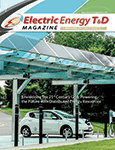EET&D : Distributed Energy Resources (DERs) are having a huge impact across multiple industries. How have they transformed the energy industry, and what is the impact on the grid?
Ipakchi : The growing volume of DERs, especially solar PV and battery storage, are having a significant impact on the power industry. At the bulk power level, PVs are impacting the system load shape, reducing net demand mid-day, and increasing ramping requirements in the early evening. As a result, some regions, such as California, have started experiencing negative market prices for energy in mid-day and higher prices in the evening. This has created opportunities for storage assets to shift demand from evening to mid-day. The intermittency of solar generation has also increased the demand for balancing and regulation services, but where the most impact is occurring is on the distribution grid.
DERs create operational and reliability issues as they impact voltage levels, phase balances, and system losses, as well as create the potential for reverse flows, which challenge protection and control systems. On the other hand, if DERs are properly managed, they can provide enhanced distribution reliability, improved supply economics, and higher levels of system resiliency. As many DERs are owned by end-use customers or aggregators, more attention also needs to be placed on customer services and customer management. Furthermore, with increased levels of customer-side and customer-owned generation, utilities need to adopt their business models with new revenue generating customer services.
Power companies need extended capabilities to manage DERs and to deal with large volumes of data for monitoring, scheduling, dispatch, and control of resources, while maintaining distribution reliability and addressing customer related issues. Distributed Energy Resource Management Systems (DERMS) are able to bring together the functionalities needed for distribution reliability management and combine them with customer side programs and services, while providing capabilities for DER management and scheduling, as well as economic optimization.
Distribution Management Systems (DMS) primarily model the electrical characteristics of the distribution grid. With the emergence of DERs, distribution utilities are no longer just operating the wires, but also managing these resources, most of which are owned by customers. A DERMS needs to manage customer contracts, various tariffs, and, perhaps soon, price-based transactions for the supply of various grid services.
EET&D : In addition to the customer service challenges, what are the engineering challenges? What happens to the grid as more and more DERs are out there?
Ipakchi : On the distribution grid, DER challenges are more localized. For example, you may see a higher penetration of solar PV and electric vehicles in a more affluent neighborhood. The circuit serving the neighborhood may experience reverse flows mid-day and higher peaks in the evening, as more people plug in their vehicles after coming home. There will be impacts on the voltages, losses on the circuit, the loading on transformers, and the substation serving the neighborhood.
If the utility has the ability to monitor and control all of these assets through a DERMS, they can drastically minimize the operational and technical impacts. They can also use the DERs to provide reactive power support and improve voltage on the circuits. Aside from demand response, using behind-the-meter assets is not a common practice in the industry at this time.
Under regulatory pressures, some utilities are considering, or have already undertaken, the non-wires alternative approach to address distribution constraints or transmission congestion issues. Surgically deployed DERs can provide load relief, voltage support, or other services needed to address these reliability issues. Other utilities now consider DERs as a component of their resource adequacy and a source of grid services, including capacity, reserves, and frequency regulation.
EET&D : Why is the ability to forecast down to the end-use level so important, and what are the factors that have to go into those forecasts?
Ipakchi : With high levels of DERs, forecasting distributed generation levels, demand, and dispatchable load at circuit levels has increasingly become an important requirement. Without it, you will only be able to operate in a reactive fashion. A system with good forecasting allows utilities to know where things are going to be in ten minutes, an hour, two hours, four hours, six hours, etc., and enables them to take corrective measures as needed. These proactive measures drastically improve economics, enhance system reliability, smooth out relationships with grid service providers, and improve overall operations.
A good forecast is driven by data. It requires information regarding the capacity of circuit locations of solar panels, electric vehicle chargers and charging patterns, storage assets, and demand response capabilities. Good forecasts can be generated when this information is combined with local weather forecasts and other statistical data.
EET&D : What are the concrete impacts utilities are feeling right now or will feel in the next one to two years?
Ipakchi : The growth of demand-side resources has a fundamental impact on the Integrated Resource Planning (IRP) process. IRP projects supply and demand needs and provides a plan for meeting demand with planned generation resources, while considering transmission and distribution needs. Traditionally, IRP relied on system load forecasts, generation, and transmission planning. As we move forward, utilities will need to take a closer look at what’s going on at the demand side, evaluate the growth of DERs, and also assess how much resource flexibility and dispatchability they can have on the demand side.
Another thing that is important is the concept of resiliency. Resiliency is different from reliability. For example, if you’re a utility out in the middle of the country, the chances of losing power for a couple of hours, or even a day during a tornado or other severe weather conditions, is something you’re trying to prepare for. Resiliency is important in this scenario so that the available DERs, combined with distribution switching, can be utilized to provide power to critical infrastructure, such as the police department, a place to charge cell phones, etc. Distributed resources can be positioned by the utility or by customers through incentives to create a resilient neighborhood or resilient districts. Investing in district energy services is something I highly recommend to all utilities, since it demonstrates customer care and their value for communities.
EET&D : Thank you, Ali. We can’t thank you enough for taking time out of your busy schedule to speak with us.
About the Author
 Dr. Ali Ipakchi has over 33 years of experience in information technology applications to power systems and electric utility operations. As the Senior Vice President of Smart Grid and Green Power at Open Access Technology International, Inc. (OATI), he is responsible for product design and development as well as business growth in Grid Modernization and Grid 3.0 areas. Prior to OATI, Dr. Ipakchi was Vice President of Integration Services at a leading consulting firm, assisting utility clients with roadmaps, specifications, and implementation strategies for operational and automation systems, particularly in the Smart Grid area. He has also held various senior management positions at leading T&D system vendors supporting power application development and system solutions delivery to the power industry. Dr. Ipakchi has led new business-line and corporate development initiatives. His areas of experience include utility and power systems operations, enterprise and operational IT systems, utility automation, System solutions for distribution, transmission and merchant operations, and for ISO and emerging DSOs. Dr. Ipakchi is co-holder of several U.S. patents on power systems applications. Dr. Ipakchi received his Ph.D. from University of California at Berkeley.
Dr. Ali Ipakchi has over 33 years of experience in information technology applications to power systems and electric utility operations. As the Senior Vice President of Smart Grid and Green Power at Open Access Technology International, Inc. (OATI), he is responsible for product design and development as well as business growth in Grid Modernization and Grid 3.0 areas. Prior to OATI, Dr. Ipakchi was Vice President of Integration Services at a leading consulting firm, assisting utility clients with roadmaps, specifications, and implementation strategies for operational and automation systems, particularly in the Smart Grid area. He has also held various senior management positions at leading T&D system vendors supporting power application development and system solutions delivery to the power industry. Dr. Ipakchi has led new business-line and corporate development initiatives. His areas of experience include utility and power systems operations, enterprise and operational IT systems, utility automation, System solutions for distribution, transmission and merchant operations, and for ISO and emerging DSOs. Dr. Ipakchi is co-holder of several U.S. patents on power systems applications. Dr. Ipakchi received his Ph.D. from University of California at Berkeley.







